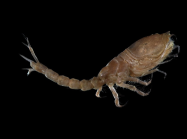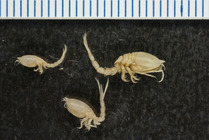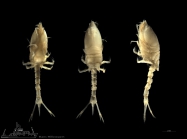Scheldt species taxon details
Diastylis rathkei (Krøyer, 1841)
110487 (urn:lsid:marinespecies.org:taxname:110487)
accepted
Species
marine, brackish, fresh, terrestrial
(of ) Krøyer, H. (1841). Fire nye arter af slægten Cuma Edw. <em>Naturhistorisk Tidsskrift Ser. II.</em> 3(6): 503-535. (look up in IMIS) [details] 
Watling, L.; Gerken, S. (2021). World Cumacea Database. Diastylis rathkei (Krøyer, 1841). Accessed through: VLIZ Consortium Scheldt Species Register at: https://www.scheldemonitor.nl/speciesregister/aphia.php?p=taxdetails&id=110487 on 2025-09-11
VLIZ Consortium. Scheldt Species Register. Diastylis rathkei (Krøyer, 1841). Accessed at: https://scheldemonitor.be/speciesregister/aphia.php?p=taxdetails&id=110487 on 2025-09-11
Date
action
by
original description
(of ) Krøyer, H. (1841). Fire nye arter af slægten Cuma Edw. <em>Naturhistorisk Tidsskrift Ser. II.</em> 3(6): 503-535. (look up in IMIS) [details] 
context source (Deepsea) Intergovernmental Oceanographic Commission (IOC) of UNESCO. The Ocean Biogeographic Information System (OBIS), available online at http://www.iobis.org/ [details]
context source (Schelde) Janssen, C.R.; Ghekiere, A.; Verslycke, T.; Vincx, M.; Fockedey, N.; Rappé, K.; De Brabander, H.; Noppe, H.; Roose, P.; Monteyne, E.; Vethaak, D.; Mees, J.; Deneudt, K. (2007). Endocrine disruption in the Scheldt estuary distribution, exposure and effects (ENDIS-RISKS). <em>Final report. Belgian Science Policy: Brussels.</em> 106 pp. (look up in IMIS) [details]
context source (BeRMS 2020) Bio-environmental research group; Institute of Agricultural and Fisheries research (ILVO), Belgium; (2015): Macrobenthos monitoring in function of the Water Framework Directive in the period 2007-2009. [details]
basis of record Watling, L. (2001). Cumacea, <B><I>in</I></B>: Costello, M.J. <i>et al.</i> (Ed.) (2001). <i>European register of marine species: a check-list of the marine species in Europe and a bibliography of guides to their identification. Collection Patrimoines Naturels,</i> 50: pp. 308-310 (look up in IMIS) [details]
additional source Muller, Y. (2004). Faune et flore du littoral du Nord, du Pas-de-Calais et de la Belgique: inventaire. [Coastal fauna and flora of the Nord, Pas-de-Calais and Belgium: inventory]. <em>Commission Régionale de Biologie Région Nord Pas-de-Calais: France.</em> 307 pp., available online at http://www.vliz.be/imisdocs/publications/145561.pdf [details]
additional source Zimmer, C. (1933). Cumacea. <i>The fauna of the North Sea and Baltic</i>, 23(10.g4). Akademische Verlagsgesellschaft: Leipzig, Germany. 70-120 pp. (look up in IMIS) [details]
additional source The Zoological Record: records of zoological literature relating chiefly to the year. Zoological Society of London City: London, UK. (look up in IMIS) [details]
context source (Deepsea) Intergovernmental Oceanographic Commission (IOC) of UNESCO. The Ocean Biogeographic Information System (OBIS), available online at http://www.iobis.org/ [details]
context source (Schelde) Janssen, C.R.; Ghekiere, A.; Verslycke, T.; Vincx, M.; Fockedey, N.; Rappé, K.; De Brabander, H.; Noppe, H.; Roose, P.; Monteyne, E.; Vethaak, D.; Mees, J.; Deneudt, K. (2007). Endocrine disruption in the Scheldt estuary distribution, exposure and effects (ENDIS-RISKS). <em>Final report. Belgian Science Policy: Brussels.</em> 106 pp. (look up in IMIS) [details]
context source (BeRMS 2020) Bio-environmental research group; Institute of Agricultural and Fisheries research (ILVO), Belgium; (2015): Macrobenthos monitoring in function of the Water Framework Directive in the period 2007-2009. [details]
basis of record Watling, L. (2001). Cumacea, <B><I>in</I></B>: Costello, M.J. <i>et al.</i> (Ed.) (2001). <i>European register of marine species: a check-list of the marine species in Europe and a bibliography of guides to their identification. Collection Patrimoines Naturels,</i> 50: pp. 308-310 (look up in IMIS) [details]
additional source Muller, Y. (2004). Faune et flore du littoral du Nord, du Pas-de-Calais et de la Belgique: inventaire. [Coastal fauna and flora of the Nord, Pas-de-Calais and Belgium: inventory]. <em>Commission Régionale de Biologie Région Nord Pas-de-Calais: France.</em> 307 pp., available online at http://www.vliz.be/imisdocs/publications/145561.pdf [details]
additional source Zimmer, C. (1933). Cumacea. <i>The fauna of the North Sea and Baltic</i>, 23(10.g4). Akademische Verlagsgesellschaft: Leipzig, Germany. 70-120 pp. (look up in IMIS) [details]
additional source The Zoological Record: records of zoological literature relating chiefly to the year. Zoological Society of London City: London, UK. (look up in IMIS) [details]
 Present
Present  Inaccurate
Inaccurate  Introduced: alien
Introduced: alien  Containing type locality
Containing type locality
Marine Life Information Network - UK
PlanktonNet Image
To Barcode of Life (10 barcodes)
To Biodiversity Heritage Library (44 publications)
To Dyntaxa
To European Nucleotide Archive, ENA (Diastylis rathkei)
To GenBank (14 nucleotides; 9 proteins)
To Global Biotic Interactions (GloBI)
To NHMUK collection (Diastylis rathkei (Krøyer, 1841); NON-TYPE; NHMUK:ecatalogue:9473862)
To PESI
To The Arctic Traits Database (13 traits)
To USNM Invertebrate Zoology Arthropoda Collection (4 records)
To ITIS
PlanktonNet Image
To Barcode of Life (10 barcodes)
To Biodiversity Heritage Library (44 publications)
To Dyntaxa
To European Nucleotide Archive, ENA (Diastylis rathkei)
To GenBank (14 nucleotides; 9 proteins)
To Global Biotic Interactions (GloBI)
To NHMUK collection (Diastylis rathkei (Krøyer, 1841); NON-TYPE; NHMUK:ecatalogue:9473862)
To PESI
To The Arctic Traits Database (13 traits)
To USNM Invertebrate Zoology Arthropoda Collection (4 records)
To ITIS




